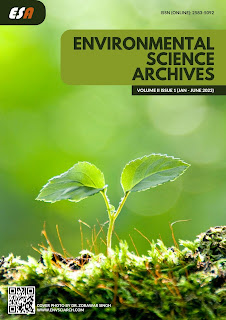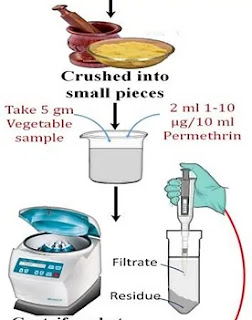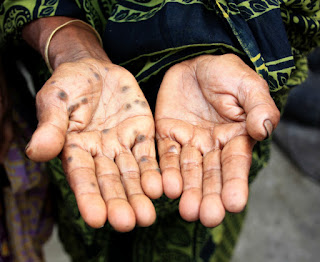ESA - VOLUME II ISSUE 1
VOLUME II ISSUE 1
Published Papers
01/01/23
Nanotoxicological Studies: Still in their Infancy
DOI: 10.5281/zenodo.7497803
Zorawar Singh
Nanoparticles have existed for millions of years on Earth and have been employed by people for different purposes. Similar in size to biological molecules like proteins, nanoparticles can exist in nature. Nanoparticles have dimensions that cannot exceed one hundred nanometers, making them much smaller than human cells. However, because of the comparatively huge amount of surface area that they cover, they are capable of having considerable specific effects. In recent years, because of the enhanced human capacity to produce synthetic nanoparticles, significant attention has been focused on nanoparticles. Nanoparticle toxicity studies have just lately emerged and are still in their infancy. More attention is needed in the field of nanoparticle toxicology in the coming years to come.
Singh Z (2023) Nanotoxicological Studies: Still in their Infancy. Environ Sci Arch 2(1):1-3.
01/01/23
Genotoxic Effect of Paraben and Oxybenzone on Root Tips of Allium cepa
DOI: 10.5281/zenodo.7497818
Jasjit Kaur Randhawa and Adeshwinder Kaur
Paraben is widely used as preservative in foodstuffs, cosmetics and pharmaceutical drugs. Oxybenzone is the most popular UV filter in skin protecting formulations or sunscreens. When washed into the water bodies both paraben and oxybenzone act as environmental contaminants. Though there are reports on cytotoxicity of Paraben and Oxybenzone on aquatic animals, studies on genotoxic and cytotoxic behavior of these on plant cells are few. This study aims to investigate cytotoxic and genotoxic impacts of Oxybenzone, Methyl paraben and Propyl paraben on root tip cells of Allium cepa, using it as an indicator organism, exposing the onion root tips to different concentrations of Oxybenzone (0.1, 0.2, 0.3, 0.4, 0.5, 0.6%), Methyl paraben and Propyl paraben (0.01, 0.05, 0.10, 0.15, 0.20, 0.25, 0.30%) that are usually used as per FDA guidelines. The maximum root length (28.6±0.3mm) was observed in 0.01% concentration of MP after 24 h, then (28.9±0.3mm) in 0.01% concentration of MP after 48 h and then (18.5±0.7mm)in 0.1% concentration of OB after 72 h. respectively. The average decrease in root length was far more prominent in MP concentrations than in OB and PP. The mitotic index of the control was found to be 32.4±0.7, 36.9±0.6 and 40.5±0.7 after 24, 48 and 72 h respectively. Mitotic index reduced to 8.9±0.5, 8.2±0.3 and 7.5±0.6 in 0.6% OB and 6.5±0.3, 5.9±0.9 and 5.1±0.8 in 0.30% MP 9.2±0.3, 8.8 ±0.4 and 8.1±0.6 in 0.30 PP after 24, 48 and 72 h of exposure. A high negative correlation was observed between Mitotic index and concentrations of OB, MP and PP. Higher concentrations OB, MP and PP disturb stages of cell division causing chromatin bridge formation, stickiness, disturbed metaphase, multiple chromosomal breaks and cell disintegration. The present study also suggests that plants being an important component of the ecosystems need to be included in evaluating the overall toxicological impact of the parabens and oxybenzone in the environment.
Randhawa JK and Kaur A (2023) Genotoxic Effect of Paraben and Oxybenzone on Root Tips of Allium cepa. Environ Sci Arch 2(1): 4-17.
02/01/23
Green Synthesized Transition Metals Nanoparticles Using Murraya koenigii Root Extract and their Comparative Study of Characterization
DOI: 10.5281/zenodo.7499520
Sivakumar C, Rathika K, Pandiarajan A and Kousalya GN
Plant root-mediated green synthesis of nanomaterials has been increasingly gaining popularity due to its eco-friendly nature and cost-effectiveness. Current work describes the green synthesis of silver and copper nanoparticles using Murraya koenigii roots extract as a capping agent. This study was conducted for the synthesis of nanoparticles using two exclusive salts (silver nitrate and copper sulfate) with the aid of Murraya koenigii root extract. We did comparative study of synthesized silver and copper nanoparticles using about 10 g of Murraya koenigii root. Roots were weighed separately and transferred into 250 ml beakers containing 100 ml distilled water and boiled for about 25 minutes. Solutions were then filtered to get clear extracts. The extract was taken for the reduction of Ag+ and Cu2+ ions, 10 ml of Murraya koenigii root extract was added drop wise to 10 ml of silver nitrate and copper sulphate solution (1:1ratio). The reduction reaction was studied by observing the colour change. Confirmation of silver and copper nanoparticles formation and plasmonic resonance can be found by analyzing the absorbance data of UV-VIS spectroscopy, Fourier Transform Infrared (FTIR), which were used to determine the functional groups on the cell surface that may be involved in the nanoparticle synthesis. Morphology and size of silver and copper nanoparticles were investigated using Scanning Electron Microscopy (SEM) and Transmission Electron Microscopy (TEM) experiments.
Sivakumar C, Rathika K, Pandiarajan A and Kousalya GN (2023) Green Synthesized Transition Metals Nanoparticles Using Murraya koenigii Root Extract and their Comparative Study of Characterization. Environ Sci Arch 2(1): 18-27.
03/01/23
Fungi: The Next Generation of Biofertilizers
DOI: 10.5281/zenodo.7500741
El-Ghwas DE, Elkhateeb WA and Daba GM
Understanding the negative impacts of using chemical fertilizers on living organisms and the environment, in general, has encouraged finding natural alternatives. Hence, biofertilizers are applied through soil or seed and are prepared from promising microbial strains (living or dormant cells) that help economically important plants in taking nutrients by interacting with their rhizosphere. Fungi are famous contributors in this field due to their ability to live in different ranges of environmental habitats and carry out processes such as nutrient cycling and decomposition of organic matter. However, many types of interactions were reported between fungi and other organisms as ants or microorganisms as bacteria. In this review, we focus on understanding what biofertilizers are, how they act and what type of interactions are noticed among them. Moreover, the classification of biofertilizers and some of their carriers are highlighted. Furthermore, we introduced examples of some fungal genera that are used as promising biofertilizers.
El-Ghwas DE, Elkhateeb WA and Daba GM (2023) Fungi: The Next Generation of Biofertilizers. Environ Sci Arch 2(1): 34-41.
03/01/23
Daphnia magna as a model animal for assessing microplastic toxicity
DOI: 10.5281/zenodo.7500694
Sanjogdeep Kaur, Heena Gupta and Zorawar Singh
Microplastics, originating directly from household and industrial products or from large plastic degradation, are currently of extreme global concern. The coronavirus pandemic also increased the use of microplastics because all the protective equipment like face masks, full face shields and gloves are made up of different plastics such as polyurethane, PET, polyester and polypropylene. The face masks generally contain a lot of polypropylene in it which produces toxicity in ocean beds and great lakes during the weathering process. Actually, weathering processes lead to the fragmentation of plastics into microplastics by affecting their physicochemical properties. Microplastics are pervasive in the environment due to the delayed disposal of plastic wastes, a lack of detection tools and particular removal procedures, and a gradual disposal rate. Due to their small size (ranging from 1 μm to 5 mm) microplastics can easily be ingested. Consequently, living organisms living in the water column as well as those found in benthic zones are threatened by the presence of microplastics. In this paper, we have discussed the effects of microplastics on Daphnia magna. The filter feeder D. magna ingest microplastics and are not able to differentiate between particles of different nature. Microplastics decreased the survival rates, body growth, reproduction and immune responses in Daphnia. Sinking microplastics also decreased the swimming velocity of Daphnia during cruising and vertical swimming trajectories. In conclusion, these findings highlight the health risks of contamination of microplastics in aquatic environments and present Daphnia as a good model animal for research in the field of microplastic toxicity.
Kaur S, Gupta H and Singh Z (2023) Daphnia magna as a model animal for assessing microplastic toxicity. Environ Sci Arch 2(1): 28-33.
15/01/23
Medicinal Properties of Miracle Plant: Moringa oleifera
DOI: 10.5281/zenodo.7538059
Anamika Singh and Ankur Omer
Phytomedicines are thought to have advantages over conventional pharmaceuticals, and recent research is rekindling interest in them. Moringa oleifera, often known as a miracle tree, drumsticks, or horseradish, is a tree with medicinal benefits. Its various parts, including the seeds, delicate pods, and leaves, are high in vitamins, minerals, amino acids, proteins, phenolic compounds, and beta-carotene. Because of their nutritional value, the leaves and branches can be used as livestock and fish feed. The growing demand for moringa-based goods that are environmentally friendly has opened up new avenues for researchers to investigate this plant. The objective of the article is to provide a comprehensive overview of Moringa species that have both nutritional and therapeutic properties.
Singh A and Omer A (2023) Medicinal Properties of Miracle Plant: Moringa oleifera. Environ Sci Arch 2(1):42-51.
16/01/23
Nematophagous Fungi as an Extraordinary Tool to Control Parasitic Nematodes: A Review
DOI: 10.5281/zenodo.7540410
Elkhateeb WA, EL-Ghwas DE and Daba GM
Due to the harmful impacts of using chemicals in controlling plant pests as nematodes, there is a current trend of employing natural pesticides that show potency together without contaminating the environment or negatively affect human and other creatures. Hence, the name of nematophagous fungi has risen as potent biocontrol tools that attack nematodes specifically without harming surrounding ecosystem. Different nematophagous fungal species act as natural predators of nematodes and soil-dwelling worms. Hence, we aimed in this review to discuss importance of nematophagous fungi, their occurrence, taxonomy and evolution. Also, describing examples of using nematophagous fungi as biological control agents. Moreover, the future of employing nematophagous fungi in general and mushrooms in particular in this field is highlighted.
Elkhateeb WA, EL-Ghwas DE and Daba GM (2023) Nematophagous Fungi as an Extraordinary Tool to Control Parasitic Nematodes: A Review. Environ Sci Arch 2(1):52-58.
25/01/23
Environmental Monitoring of Bore Water Quality at Selected Locations in Kottapatti Village
DOI: 10.5281/zenodo.7569182
Pandiarajan A, Shanmugaselvan R and Dheenadayalan MS
The present study aims at determining the suitability of ground water quality for drinking purposes at selected locations in Kottapatti Village at Dindigul District. Dindigul is one of the important places for its tannery units. It has more than 50 tannery units in and around the city and nearly 30 units are under processing of leather. It is a known fact that processing of leather requires a large amount of freshwater along with various chemicals. Groundwater is the main source of drinking water in Dindigul. The leather industry in and around the Dindigul city pollutes both surface and groundwater by discharging their wastes. Hence, the present study has been undertaken to determine the physico-chemical characteristics of groundwater in some selected locations in Kottapatti Village at Dindigul District. Various water samples were taken at three different locations. The samples are analyzed for physico-chemical parameters. The results were compared with drinking water standards of Bureau of Indian Standards (IS:10500) and World Health Organization Standards (WHO, 2011). Further, the correlation among different parameters of water were also estimated.
Pandiarajan A, Shanmugaselvan R and Dheenadayalan MS (2023) Environmental Monitoring of Bore Water Quality at Selected Locations in Kottapatti Village. Environ Sci Arch 2(1): 59-64.
01/02/23
Studies on Mechanical Properties of Jute Sliver Reinforced Unsaturated Polyester Resin (UPE) Composite
DOI: 10.5281/zenodo.7592777
Rashid MM, Rahman MO, Khan MH, Himel MFA, Hossain HMZ and Khatun M
Natural fiber reinforced composites are potentially useful materials with respect to environmental concerns. The geometry or the forms of the reinforcement in a composite greatly influences the mechanical properties of the composite. The common forms of jute reinforcement are chopped fiber, sliver, yarn, woven fabric, knitted fabric and nonwoven mat. In the present study, Composites were fabricated by incorporating jute sliver in unsaturated polyester (UPE) resin. Jute sliver (JS) reinforced unsaturated polyester (UPE) resin composites [JS/UPE] were prepared by compression molding technique. Jute fiber content in the composites were varied from 10-60% by weight and mechanical properties were measured in both longitudinal (along fiber/sliver axis) and transverse direction. Composite comprised of 50% jute sliver showed the best mechanical properties. At optimized fiber content (5o% fiber by weight) the value TS, TM, BS, BM and IS of jute sliver reinforced UPE composite, JS/UPE, were found to 140.25 MPa, 6.75GPa, 160.5. MPa, 13.7 GPa and 27.2 KJ/m2 in longitudinal direction and 18.32 MPa, 0.8 GPa, 44.1 MPa, 1.3 GPa and 5.2 KJ/m2 in transverse direction respectively.
Rashid MM, Rahman MO, Khan MH, Himel MFA, Hossain HMZ and Khatun M (2023) Studies on Mechanical Properties of Jute Sliver Reinforced Unsaturated Polyester Resin (UPE) Composite. Environ Sci Arch 2(1):65-74.
02/03/23
Impact of Iron Oxide Nanoparticles on the Growth, Vermicomposting Efficiency and Nutritional Status of Vermicompost through Eisenia fetida
DOI: 10.5281/zenodo.7691979
Goyal A, Rani N, Hundal SS and Dhingra N
The advent of nanotechnology has led to the presence of an enormous amount of nanoparticles (NPs) in the environment, especially in the soil where earthworms, the major megafaunal species, are continuously exposed to these NPs. The present study focuses on the impact of iron oxide NPs on the vermicomposting efficiency of Eisenia fetida. The worms were exposed to iron oxide NPs of sizes 30 nm and 100 nm at different concentrations (250, 500, 750, and 1000 mg kg-1 of soil) spiked in artificial soil. The maximum increase in earthworm’s weight of 4.10% was observed at a concentration of 250 mg kg-1 of soil for the iron oxide NPs of 30 nm size and the highest increase in weight of 11.50% was observed in the case of 100 nm size at a concentration of 750 mg kg-1 of soil. In the treatment containing a combination of iron oxide NPs of both sizes, the highest gain in weight of 8.06% was observed at a concentration of 500 mg kg-1 of soil. The number of days for vermicompost preparation from the substrate was recorded to be 82, 89 and 92, respectively, for the control, treatments containing 30 nm and 100 nm iron oxide NPs. The maximum number of days (93 days) was recorded in the treatment containing both 30 nm and 100 nm iron oxide NPs. The nutrient analysis of the vermicompost from the substrates revealed a general trend of increasing levels of total nitrogen, potassium and phosphorus (%) along with decreasing levels of pH and total organic carbon content (%). It is inferred that iron oxide NPs caused morphological damage and colour change to Eisenia fetida. The NPs result in an increased duration for vermicomposting but better nutrient content as compared to the control. The nutrient content of vermicompost was found to be the highest for the treatment containing a combination of both sizes of iron oxide NPs. Therefore, the impact of iron oxide NPs in vermicomposting can potentially be explored by marginal farmers in developing countries to support farming practices.
Goyal A, Rani N, Hundal SS and Dhingra N (2023) Impact of Iron Oxide Nanoparticles on the Growth, Vermicomposting Efficiency and Nutritional Status of Vermicompost through Eisenia fetida. Environ Sci Arch 2(1): 75-85.




How to submit a paper in Environmental Science Archives ?
ReplyDeleteThanks for your query. You have to email the word document to environmentalsciencearchives@gmail.com
ReplyDelete